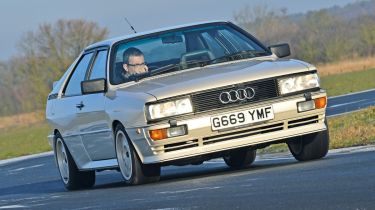Audi Ur-Quattro
The original rally-bred Audi Quattro is still brilliant fun after 23 years
The original and still the best, the Ur-Quattro has withstood the test of time incredibly well. Faded brakes meant it was much slower at the track than the A1, but overall the narrow gap in performance is a testament to how far ahead of its time this car was in the eighties. Well kept used examples can still be found for around £16,000 and are very likely to increase in value, so it’s also something of a bargain.
Cult cars like the Audi Quattro need no introduction. This model single-handedly transformed the world of rallying and defined the evolution of sports cars.
When it first arrived in 1980, the only previous four-wheel-drive sports car was the agricultural and hugely expensive Jensen FF of 1966. But with its modern transmission, firebreathing turbocharged engine and massive grip, the Quattro boasted the kind of performance rivals could only dream about.
A quick glance at the facts and figures suggests the difference between old and new isn’t that big. Despite being slightly larger, the 1991 Quattro we tested is actually 10kg lighter than the Audi A1 quattro, at 1,380kg. Yet while the 217bhp, 2.2-litre turbo five-cylinder engine was considered powerful back in the day, it trails the A1, with its 253bhp output.
Used - available now

2024 Cupra
Formentor
79,227 milesAutomaticPetrol1.4L
Cash £17,000
2020 BMW
5 Series Touring
44,522 milesAutomaticPetrol2.0L
Cash £19,700
2024 Cupra
Formentor
30,325 milesAutomaticPetrol1.5L
Cash £22,600
2022 Toyota
C-HR
29,717 milesAutomaticPetrol1.8L
Cash £20,000When the Quattro made its debut at the 1980 Geneva Motor Show, some criticised its squat shape, which was the work of British designer Martin Smith. But today, it looks close to perfect. Even though the wheels are just 15 inches in diameter, they fill the car’s hefty arches properly, while details like the embossed Coupé logo across the boot and subtle rear air vents draw the eye.
The interior is a little less glamorous than the gadget-laden A1’s, but the orange LCD dials evoke a wonderful sense of nostalgia, and the electric windows and extending radio aerial still work just fine – a testament to Audi’s build quality. The later version we tested came with half-leather sports seats and a contoured three-spoke steering wheel that give an extra-special feel.
So the cabin has aged well, but can the Quattro still keep up on track? Under the bonnet lies an engine that fully deserves its hallowed reputation. Our 20-valve Quattro had covered more than 70,000 miles, yet it still delivered scintillating mid-range punch. Plus, the evocative five-cylinder warble fills the cabin every time you accelerate through the gears.
Cars of this vintage often need to be handled with care, but our example had retained the natural agility of its youth.
The steering was a real highlight: heavy, yet direct and wonderfully communicative, with a purity that the A1’s clinical, electrically assisted set-up lacks. And the grippy chassis still gives you the confidence to corner at high speed on a wet or dry surface.
Lean on the suspension and it shows impressive composure, while only the long-throw gearbox and spongy brakes give away the Quattro’s age. It felt planted even in freezing conditions, and the balance was more neutral than in the twitchy A1.
Even a short drive was enough to cement the Quattro’s reputation, and its dynamic brilliance remains undiluted. It definitely deserves a space in anyone’s dream garage.







